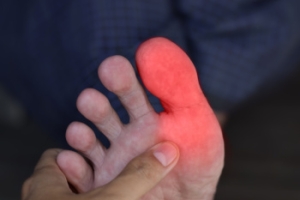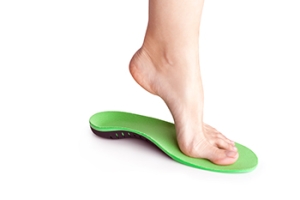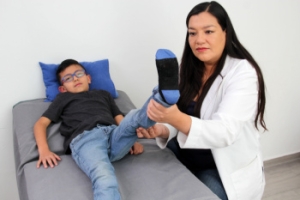
Causes of Toe Pain
 Toe pain can arise from various conditions, each requiring careful attention. Bunions, a common cause, involve a bony bump forming at the base of the big toe, leading to discomfort and swelling. Arthritis, particularly osteoarthritis and rheumatoid arthritis, can cause joint inflammation and stiffness, affecting toe movement. Infections, whether fungal or bacterial, may result in redness, swelling, and severe pain. Injuries such as fractures or sprains often lead to immediate and intense pain, impairing mobility. Peripheral artery disease, or PAD, restricts blood flow to the extremities, causing pain, especially during walking. If you have toe pain, it is suggested that you visit a podiatrist who can determine the cause and offer appropriate treatment solutions.
Toe pain can arise from various conditions, each requiring careful attention. Bunions, a common cause, involve a bony bump forming at the base of the big toe, leading to discomfort and swelling. Arthritis, particularly osteoarthritis and rheumatoid arthritis, can cause joint inflammation and stiffness, affecting toe movement. Infections, whether fungal or bacterial, may result in redness, swelling, and severe pain. Injuries such as fractures or sprains often lead to immediate and intense pain, impairing mobility. Peripheral artery disease, or PAD, restricts blood flow to the extremities, causing pain, especially during walking. If you have toe pain, it is suggested that you visit a podiatrist who can determine the cause and offer appropriate treatment solutions.
Toe pain can disrupt your daily activities. If you have any concerns, contact Pasquale Cancelliere, DPM of Candria Foot and Ankle Specialists. Our doctor can provide the care you need to keep you pain-free and on your feet.
What Causes Toe Pain?
Most severe toe pain is caused due to a sports injury, trauma from dropping something heavy on the toe, or bumping into something rigid. Other problems can develop over time for various reasons.
Toe pain can be caused by one or more ailments. The most common include:
- Trauma
- Sports injury
- Wearing shoes that are too tight
- Arthritis
- Gout
- Corns and calluses
- Hammertoe
- Bunions
- Blisters
- Ingrown toenails
- Sprains
- Fractures (broken bones)
- Dislocations
When to See a Podiatrist
- Severe pain
- Persistent pain that lasts more than a week
- Signs of infection
- Continued swelling
- Pain that prevents walking
Diagnosis
In many cases the cause of toe pain is obvious, but in others, a podiatrist may want to use more advanced methods to determine the problem. These can range from simple visual inspections and sensation tests to X-rays and MRI scans. Prior medical history, family medical history, and any recent physical traumatic events will all be taken into consideration for a proper diagnosis.
Treatment
Treatments for toe pain and injuries vary and may include shoe inserts, padding, taping, medicines, injections, and in some cases, surgery. If you believe that you have broken a toe, please see a podiatrist as soon as possible.
If you have any questions please feel free to contact our offices located in Londonderry, NH and Salem, NH . We offer the newest diagnostic tools and technology to treat your foot and ankle needs.
Toe Pain
Toe pain can originate from corns, calluses, hammertoes, and bunions, as well as ingrown toenails, sprains, fractures, and dislocations. Corns develop as the toe rubs against the inside of a shoe which causes the skin to thicken as a form of protection. A corn is typically cone-shaped and has a small, hardened spot that points inward. When a corn is pressed into the skin, the toe becomes painful. Corns usually form on the top or side of the toe. A callus is also a thickened patch of skin that generally forms on the bottom of the foot. Calluses are the result of friction from the toe rubbing against the inside of a shoe. They may also occur by walking barefoot or having flat feet. A hammertoe is a bump on the knuckle of the second toe that is produced by wearing shoes that are too short for your feet. The bony protrusion rubs against the top of the shoe causing pain and irritation. A bunion is a malformation of the big toe. The base of the big toe pushes away from the smaller toes, forcing the top of the big toe to press toward the other toes. Bunions can be hereditary, or they can result from injury to the toe joint or from wearing high heels with a narrow toe box. The toe becomes inflamed, and a bump may develop at the end of the misplaced bone. Ingrown toenails typically affect the big toe and its surrounding skin. The nail will dig into the skin and become painful. Wearing tight or narrow shoes that compress the big toe causes the nail to grow into the fleshy part of the toe. Cutting toenails incorrectly can also add to the development of an ingrown toenail. A toe sprain originates from a torn or stretched ligament. Strapping the injured toe to the toe next to it for stabilization is common. A broken or fractured toe usually occurs from trauma like dropping a heavy object on it or bumping into something extremely hard and rigid. Osteoporosis, a thinning of the bones, can also bring about toe fractures.
Any of the conditions mentioned can lead to pain and irritation. While some are more serious than others, seeking an examination and diagnosis from a podiatrist is a good idea. A podiatrist can treat each ailment and get you back on your feet again without pain.
Different Types of Orthotics for Foot Pain
 Orthotics are devices placed inside shoes to support and comfort the feet, often used to treat foot pain. Custom orthotics are tailor-made for an individual's foot shape and specific needs, while prefabricated orthotics are mass-produced and designed to fit most feet. Both types of orthotics help alleviate foot pain, improve alignment, and provide support. They are commonly used for conditions like plantar fasciitis, flat feet, high arches, and arthritis. Custom orthotics offer precise correction and cushioning, addressing unique foot structures and biomechanical issues. They can be especially beneficial for severe or specific conditions. Prefabricated orthotics are more affordable and accessible, providing adequate support for mild to moderate foot pain. They can be effective for general use but may not address all individual needs as accurately as custom orthotics. Both types of orthotics are useful, but their effectiveness depends on the specific foot condition and individual requirements. For proper assessment and advice, it is suggested that you visit a podiatrist.
Orthotics are devices placed inside shoes to support and comfort the feet, often used to treat foot pain. Custom orthotics are tailor-made for an individual's foot shape and specific needs, while prefabricated orthotics are mass-produced and designed to fit most feet. Both types of orthotics help alleviate foot pain, improve alignment, and provide support. They are commonly used for conditions like plantar fasciitis, flat feet, high arches, and arthritis. Custom orthotics offer precise correction and cushioning, addressing unique foot structures and biomechanical issues. They can be especially beneficial for severe or specific conditions. Prefabricated orthotics are more affordable and accessible, providing adequate support for mild to moderate foot pain. They can be effective for general use but may not address all individual needs as accurately as custom orthotics. Both types of orthotics are useful, but their effectiveness depends on the specific foot condition and individual requirements. For proper assessment and advice, it is suggested that you visit a podiatrist.
If you are having discomfort in your feet and would like to try orthotics, contact Pasquale Cancelliere, DPM from Candria Foot and Ankle Specialists. Our doctor can provide the care you need to keep you pain-free and on your feet.
What Are Orthotics?
Orthotics are inserts you can place into your shoes to help with a variety of foot problems such as flat feet or foot pain. Orthotics provide relief and comfort for minor foot and heel pain but can’t correct serious biomechanical problems in your feet.
Over-the-Counter Inserts
Orthotics come in a wide variety of over-the-counter inserts that are used to treat foot pain, heel pain, and minor problems. For example, arch supports can be inserted into your shoes to help correct overarched or flat feet, while gel insoles are often used because they provide comfort and relief from foot and heel pain by alleviating pressure.
Prescription Orthotics
If over-the-counter inserts don’t work for you or if you have a more severe foot concern, it is possible to have your podiatrist prescribe custom orthotics. These high-quality inserts are designed to treat problems such as abnormal motion, plantar fasciitis, and severe forms of heel pain. They can even be used to help patients suffering from diabetes by treating foot ulcers and painful calluses and are usually molded to your feet individually, which allows them to provide full support and comfort.
If you are experiencing minor to severe foot or heel pain, it’s recommended to speak with your podiatrist about the possibilities of using orthotics. A podiatrist can determine which type of orthotic is right for you and allow you to take the first steps towards being pain-free.
If you have any questions please contact our offices located in Londonderry, NH and Salem, NH . We offer the newest diagnostic and treatment technologies for all your foot and ankle needs.
Foot Orthotics
Orthotics are shoe inserts that are meant to correct an irregular walking gait or provide cushioning to the feet. Orthotics come in a variety of different models and sizes, including over-the-counter and customizable variants. Customizable orthotics can be shaped and contoured to fit inside a specific shoe and are typically prescribed through a podiatrist who specializes in customized footwear and orthotics design and management.
Orthotics are beneficial because they can help prevent injuries from occurring and provide cushioning to keep pain levels down to a minimum. They also allow for the correct positioning of the feet. Orthotics can act as shock absorbers to help remove pressure from the foot and ankle. Therefore, orthotics can make bodily movements, such as walking and running, become more comfortable as well as help prevent the development of certain foot conditions.
Orthotics alleviate pain and make the foot more comfortable by slightly altering the angle at which the foot strikes the ground surface, therefore controlling the movement of the foot and ankle. Orthotics come in different variants and can be made of various materials. To determine what type of orthotic is most suited to your feet and your needs, it is best to consult your podiatrist. He or she will be able to recommend a type of orthotic that can help improve your foot function or prescribe a custom orthotic to best fit your feet.
Key Factors and Tips About Ankle Injuries While Running

Ankle injuries while running are common and can be caused by several factors. Overtraining often leads to fatigue, increasing the risk of improper form and accidents. Muscle strains can occur from inadequate warm-ups or sudden increases in intensity. Wearing the wrong shoes, especially those lacking proper support, can lead to instability and misalignment. To prevent these injuries, it is essential to incorporate rest days into your training schedule to allow muscles to recover. Ensuring a thorough warm-up before running can prepare muscles and reduce the risk of strains. Investing in high-quality running shoes that provide adequate support and cushioning is essential for maintaining proper form and stability. Listening to your body and avoiding pushing through pain can also help prevent serious injuries. If you have sudden or chronic ankle pain from running, it is suggested that you visit a podiatrist who can effectively treat this condition.
Ankle and foot injuries are common among athletes and in many sports. They can be caused by several problems and may be potentially serious. If you are feeling pain or think you were injured in a sporting event or when exercising, consult with Pasquale Cancelliere, DPM from Candria Foot and Ankle Specialists. Our doctor will assess your condition and provide you with quality foot and ankle treatment.
Common Injuries
The most common injuries that occur in sporting activities include:
- Achilles Tendonitis
- Achilles Tendon Rupture
- Ankle Sprains
- Broken Foot
- Plantar Fasciitis
- Stress Fractures
- Turf Toe
Symptoms
Symptoms vary depending upon the injury and in some cases, there may be no symptoms at all. However, in most cases, some form of symptom is experienced. Pain, aching, burning, bruising, tenderness, tightness or stiffness, sensation loss, difficulty moving, and swelling are the most common symptoms.
Treatment
Just as symptoms vary depending upon the injury, so do treatment options. A common treatment method is known as the RICE method. This method involves rest, applying ice, compression and elevating the afflicted foot or ankle. If the injury appears to be more serious, surgery might be required, such as arthroscopic or reconstructive surgery. Lastly, rehabilitation or therapy might be needed to gain full functionality in the afflicted area. Any discomfort experienced by an athlete must be evaluated by a licensed, reputable medical professional.
If you have any questions, please feel free to contact our offices located in Londonderry, NH and Salem, NH . We offer the newest diagnostic and treatment technologies for all your foot care needs.
Sports Related Foot and Ankle Injuries
Foot and ankle injuries are common among athletes and those who exercise frequently. Most of these injuries are non-life-threatening and can heal in weeks with proper treatment and care. Serious injuries, however, require urgent medical treatment.
Common minor injuries include ankle sprains, ankle strains, Achilles tendonitis, plantar fasciitis, stress fractures, and turf toe. An ankle sprain is when the ligaments in the ankle have either become stretched or torn. When the muscle or tendon is stretched or torn, it is an ankle strain. When the big toe is sprained, it is known as turf toe. Achilles tendonitis is the overuse and inflammation of the Achilles tendon. Plantar fasciitis is the inflammation of the plantar fascia and generally occurs from overuse in athletics. Stress fractures are also caused from overuse and are small cracks in the bone.
Achilles tendon ruptures are common, but more serious. This injury occurs when the Achilles tendon, the largest tendon in the body, ruptures. In most cases, this causes severe pain and difficulty walking; some who have experienced this injury have reported, however, no signs or symptoms. A laceration is a deep cut that can occur anywhere on the body. Lacerations on the foot are rarer, but can occur from things like metal cleats landing on the foot.
Treatment options cover a wide range of methods based upon the injury and its severity. Conditions like plantar fasciitis, stress fractures, Achilles tendonitis, turf toe and ankle sprains/ strains can heal on their own without immediate medical care, but seeing a podiatrist to monitor the injury is always recommended. Following the RICE (Rest, Icing, Compression, and Elevation) protocol is generally enough to treat minor injuries. This means resting the foot by either keeping pressure off the foot or not walking at all. Icing the injury will help reduce swelling and pain. Compressing the wound with a wrap will immobilize and help promote healing. Finally, keeping the wound elevated will also reduce swelling and also help the healing process.
It is important to note that even minor injuries can vary in severity, with grade one being a minor injury and grade three requiring urgent care by a podiatrist. Achilles tendon ruptures and lacerations on the foot generally require urgent medical care and treatment options that need a podiatrist. These could include imaging tests, stitches for cuts, rehabilitation, and casts or braces. Every case is different, however, so it is always recommended to see a podiatrist when pain in the foot does not disappear.
Let the Expert Treat Your Ingrown Toenails
Taking Care of Feet While Traveling
 Traveling often leads to tired and achy feet due to prolonged periods of walking, standing, or sitting. These activities can cause swelling, discomfort, and fatigue in the feet, especially when confined to tight spaces like airplane cabins or car seats. The lack of movement restricts blood flow, causing fluid to pool in the lower extremities. This can result in a sensation of heaviness, throbbing, or even pain. To soothe tired and achy feet while traveling, take regular breaks to stretch and walk around, promoting better circulation. Elevate your feet when possible to reduce swelling. Wearing comfortable, supportive shoes and compression socks can also alleviate discomfort. Gentle foot massages can help reduce inflammation and provide relief. Additionally, staying hydrated and avoiding excessive salt intake can also prevent fluid retention. If foot pain persists or becomes severe, it is suggested that you visit a podiatrist for a thorough evaluation and personalized advice.
Traveling often leads to tired and achy feet due to prolonged periods of walking, standing, or sitting. These activities can cause swelling, discomfort, and fatigue in the feet, especially when confined to tight spaces like airplane cabins or car seats. The lack of movement restricts blood flow, causing fluid to pool in the lower extremities. This can result in a sensation of heaviness, throbbing, or even pain. To soothe tired and achy feet while traveling, take regular breaks to stretch and walk around, promoting better circulation. Elevate your feet when possible to reduce swelling. Wearing comfortable, supportive shoes and compression socks can also alleviate discomfort. Gentle foot massages can help reduce inflammation and provide relief. Additionally, staying hydrated and avoiding excessive salt intake can also prevent fluid retention. If foot pain persists or becomes severe, it is suggested that you visit a podiatrist for a thorough evaluation and personalized advice.
Foot Pain
Foot pain can be extremely painful and debilitating. If you have a foot pain, consult with Pasquale Cancelliere, DPM from Candria Foot and Ankle Specialists. Our doctor will assess your condition and provide you with quality foot and ankle treatment.
Causes
Foot pain is a very broad condition that could be caused by one or more ailments. The most common include:
- Bunions
- Hammertoes
- Plantar Fasciitis
- Bone Spurs
- Corns
- Tarsal Tunnel Syndrome
- Ingrown Toenails
- Arthritis (such as Gout, Rheumatoid, and Osteoarthritis)
- Flat Feet
- Injury (from stress fractures, broken toe, foot, ankle, Achilles tendon ruptures, and sprains)
- And more
Diagnosis
To figure out the cause of foot pain, podiatrists utilize several different methods. This can range from simple visual inspections and sensation tests to X-rays and MRI scans. Prior medical history, family medical history, and any recent physical traumatic events will all be taken into consideration for a proper diagnosis.
Treatment
Treatment depends upon the cause of the foot pain. Whether it is resting, staying off the foot, or having surgery; podiatrists have a number of treatment options available for foot pain.
If you have any questions, please feel free to contact our offices located in Londonderry, NH and Salem, NH . We offer the newest diagnostic and treatment technologies for all your foot care needs.
Foot Pain
The feet, being the foundation of the body, carry all of the body’s weight and are therefore prone to experiencing pain and discomfort. If you are experiencing foot pain, it is important to determine where in the foot you are experiencing this pain to help discover the cause of it. While pain can be experienced virtually anywhere in the foot, the most common sites of foot pain are in the heel and ankle.
Heel pain can be due to a multitude of conditions including plantar fasciitis, Achilles tendinitis, and heel spurs. Pain experienced in the ankle can be a sign of an ankle sprain, arthritis, gout, ankle instability, ankle fracture, or nerve compression. In more serious cases, pain in the foot can be a sign of improper alignment or an infection.
Foot pain can be accompanied by symptoms including redness, swelling, stiffness and warmth in the affected area. Whether the pain can be described as sharp or dull depends on the foot condition behind it. It is important to visit your local podiatrist if your foot pain and its accompanying symptoms persist and do not improve over time.
Depending on the location and condition of your foot pain, your podiatrist may prescribe certain treatments. These treatments can include but are not limited to prescription or over-the-counter drugs and medications, certain therapies, cortisone injections, or surgery.
If you are experiencing persistent foot pain, it is important to consult with your foot and ankle doctor to determine the cause and location. He or she will then prescribe the best treatment for you. While milder cases of foot pain may respond well to rest and at-home treatments, more serious cases may take some time to fully recover.
Idiopathic Toe Walking in Children

Idiopathic toe walking is a phenomenon where children habitually walk on their toes without any underlying medical condition or known cause. While toe walking is common in toddlers who are learning to walk, persistent toe walking beyond the age of three without any identifiable cause can be a cause for concern. Children with idiopathic toe walking typically walk on their toes with their heels off the ground during most or all of their walking activities. This behavior can affect their balance, coordination, and overall motor development. While the exact cause of idiopathic toe walking remains unclear, it is believed to involve a combination of factors including tightness in the calf muscles, sensory processing issues, or developmental delays. Early intervention is vital in addressing idiopathic toe walking and preventing potential complications such as muscle stiffness or contractions. Treatment may involve specific stretches that can strengthen the calf muscles, orthotic devices to encourage heel contact, and monitoring to track developmental progress and address any underlying issues. If your child has this condition, it is strongly suggested that you seek the advice of a podiatrist who can guide you toward appropriate treatment measures.
Making sure that your children maintain good foot health is very important as they grow. If you have any questions, contact Pasquale Cancelliere, DPM of Candria Foot and Ankle Specialists. Our doctor can provide the care you need to keep you pain-free and on your feet.
Keeping Children's Feet Healthy
Having healthy feet during childhood can help prevent medical problems later in life, namely in the back and legs. As children grow, their feet require different types of care. Here are some things to consider...
Although babies do not walk yet, it is still very important to take care of their feet.
Avoid putting tight shoes or socks on his or her feet.
Allow the baby to stretch and kick his or her feet to feel comfortable.
As a toddler, kids are now on the move and begin to develop differently. At this age, toddlers are getting a feel for walking, so don’t be alarmed if your toddler is unsteady or ‘walks funny’.
As your child gets older, it is important to teach them how to take care of their feet.
Show them proper hygiene to prevent infections such as fungus.
Be watchful for any pain or injury.
Have all injuries checked by a doctor as soon as possible.
Comfortable, protective shoes should always be worn, especially at play.
If you have any questions please feel free to contact our offices located in Londonderry, NH and Salem, NH . We offer the newest diagnostic and treatment technologies for all your foot and ankle needs.










